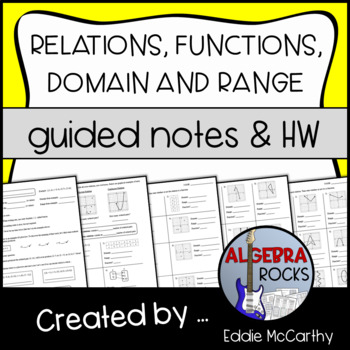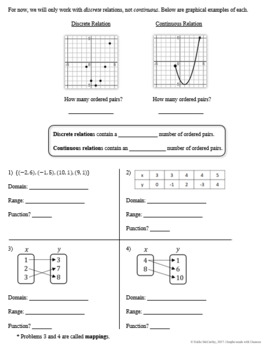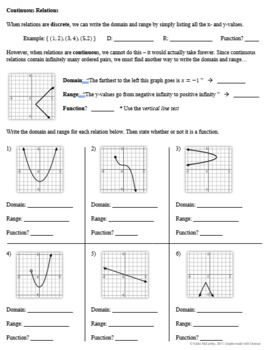Relations, Functions, Domain and Range - Guided Notes and Homework
Eddie McCarthy
1.2k Followers
Resource Type
Standards
CCSSHSF-IF.A.1
CCSSHSF-IF.B.5
Formats Included
- Zip
Pages
8 pages
Eddie McCarthy
1.2k Followers
What educators are saying
I used mostly this worksheet but I also took some inspiration from the worksheet to create another worksheet for my students for the following day
This was a great beginning of the year review of basic functions, domain, and range. I used this to get my students in the swing of things before we moved on to parent functions and transformations.
Description
This 8-page lesson contains 5 pages of guided notes and 3 pages of homework.
* Click the preview for details! *
The first half of this lesson covers discrete relations, and the second half covers continuous relations. In this lesson, students will:
- Discover what makes a relation a function
- Learn the difference between discrete and continuous
- Discover and understand the implications of the vertical line test
- Find the domain and range of discrete relations (tables, mappings, graphs)
- Find the domain and range of continuous relations (graphs)
Related lesson:
Total Pages
8 pages
Answer Key
Included
Teaching Duration
3 days
Report this resource to TPT
Reported resources will be reviewed by our team. Report this resource to let us know if this resource violates TPT’s content guidelines.
Standards
to see state-specific standards (only available in the US).
CCSSHSF-IF.A.1
Understand that a function from one set (called the domain) to another set (called the range) assigns to each element of the domain exactly one element of the range. If 𝘧 is a function and 𝘹 is an element of its domain, then 𝘧(𝘹) denotes the output of 𝘧 corresponding to the input 𝘹. The graph of 𝘧 is the graph of the equation 𝘺 = 𝘧(𝘹).
CCSSHSF-IF.B.5
Relate the domain of a function to its graph and, where applicable, to the quantitative relationship it describes. For example, if the function 𝘩(𝘯) gives the number of person-hours it takes to assemble 𝘯 engines in a factory, then the positive integers would be an appropriate domain for the function.





